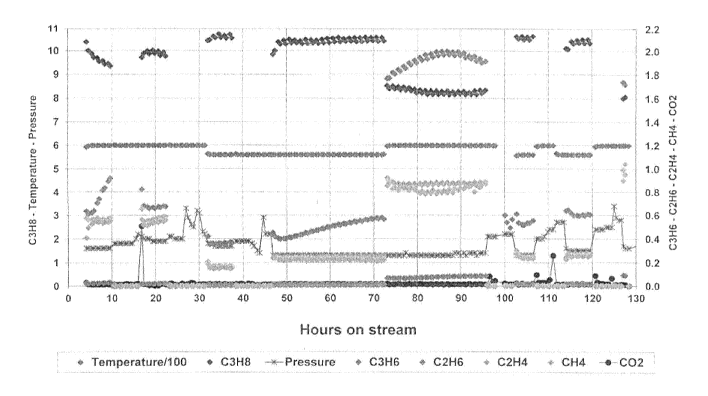English Abstract
CA 03015144 2018-08-17
(12) INTERNATIONAL APPLICATION PUBLISHED UNDER THE PATENT COOPERATION TREATY
(PCT)
(19) World Intellectual Property
Organization
1111111101111011101010111110101111101110111110101011111101101111111011110111111
International Bureau
(10) International Publication Number
(43) International Publication Date WO 2017/162431 Al
28 September 2017 (28.09.2017) WIPO I PCT
(51) International Patent Classification: KP, KR, KW, KZ, LA, LC, LK, LR,
LS, LU, LY, MA,
B01J 27/04 (2006.01) C07C 11/06 (2006.01) MD, ME, MG, MK, MN,
MW, MX, MY, MZ, NA, NG,
CO7C 5/32 (2006.01) CO7C 11/08 (2006.01) NI, NO, NZ, OM, PA,
PE, PG, PH, PL, PT, QA, RO, RS,
CO7C 11/04 (2006.01) CO7C 11/09 (2006.01) RU, RW, SA, SC, SD,
SE, SG, SK, SL, SM, ST, SV, SY,
TH, TJ, TM, TN, TR, TT, TZ, UA, UG, US, UZ, VC, VN,
(21) International Application Number: ZA, ZM, ZW.
PCT/EP2017/055289
(84) Designated States (unless otherwise indicated, for every
(22) International Filing Date:
kind of regional protection available): ARIPO (BW, GH,
7 March 2017 (07.03.2017)
GM, KE, LR, LS, MW, MZ, NA, RW, SD, SL, ST, SZ,
(25) Filing Language: English TZ, UG, ZM, ZW), Eurasian
(AM, AZ, BY, KG, KZ, RU,
TJ, TM), European (AL, AT, BE, BG, CH, CY, CZ, DE,
(26) Publication Language: English DK, EE, ES, FI, FR, GB,
GR, HR, HU, IE, IS, IT, LT, LU,
(30) Priority Data: LV, MC, MK, MT, NL, NO, PL, PT,
RO, RS, SE, SI, SK,
PA 2016 00175 22 March 2016 (22.03.2016) DK SM, TR), OAPI (BF, BJ, CF,
CG, CI, CM, GA, GN, GQ,
GW, KM, ML, MR, NE, SN, TD, TG).
(71) Applicant: HALDOR TOPSOE A/S [DK/DK]; Haldor
Topsoes Allé 1, 2800 Kgs. Lyngby (DK). Declarations under Rule 4.17:
¨ (72) Inventors: HLOLUND NIELSEN, Poul Erik; Rolandsvej as to the
identity of the inventor (Rule 4.17(i,i)
3, 3480 Fredensborg (DK). NIELSEN, Rasmus Munks- ¨ as to applicant's
entitlement to apply for and be granted a
Ord; Hellevangen 15, 2760 Malov (DK). LEMUS- patent (Rule 4.17(ii))
YEGRES, Lived J.; Kvintus Allé 14, ST. 1., 2300 Copen-
as to the applicant's entitlement to claim the priority of the
hagen S (DK).
earlier application (Rule 4.17(iii))
(81) Designated States (unless otherwise indicated, for every of
inventorship (Rule 4.17(iv))
kind of national protection available): AE, AG, AL, AM,
AO, AT, AU, AZ, BA, BB, BG, BH, BN, BR, BW, BY, Published:
BZ, CA, CH, CL, CN, CO, CR, CU, CZ, DE, DJ, DK, DM, _ with international
search report (Art. 21(3))
DO, DZ, EC, EE, EG, ES, FI, GB, GD, GE, GH, GM, GT,
HN, HR, HU, ID, IL, IN, IR, IS, JP, KE, KG, KH, KN,
(54) Title: LEAD SULFIDE AS ALKANE DEHYDROGENATION CATALYST
11 2.2
9
e 4, ids g
2
g 5
C 0
6
1 I C2
0 18 20 ¨ , SO GO 70 SO
121 130
71'
Hours on stream
¨ PreSsi,r4s 4 C2H6 ¨ C314 -
iv- CO2
(57) Abstract: A catalyst for the dehydrogenation of alkanes to alkenes
comprises lead(II) sulfide (PbS) as catalytically active mater -
ial supported on a carrier. The dehydrogenation is carried out at a
temperature between 500 and 650 C and at a pressure from 0.5 bar
" below ambient pressure to 5 bar above ambient pressure.
French Abstract
Cette invention concerne un catalyseur de déshydrogénation d'alcanes en alcènes, comprenant du sulfure de plomb (II) en tant que matériau actif du point de vue catalytique, supporté sur un support. La déshydrogénation est réalisée à une température de 500 à 650 °C et à une pression allant de 0,5 bar en dessous de la pression ambiante à 5 bars au-dessus de la pression ambiante.
